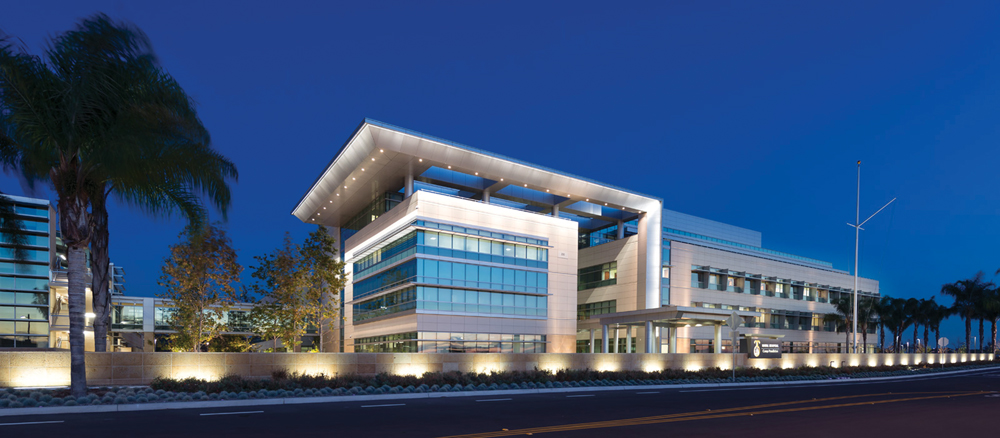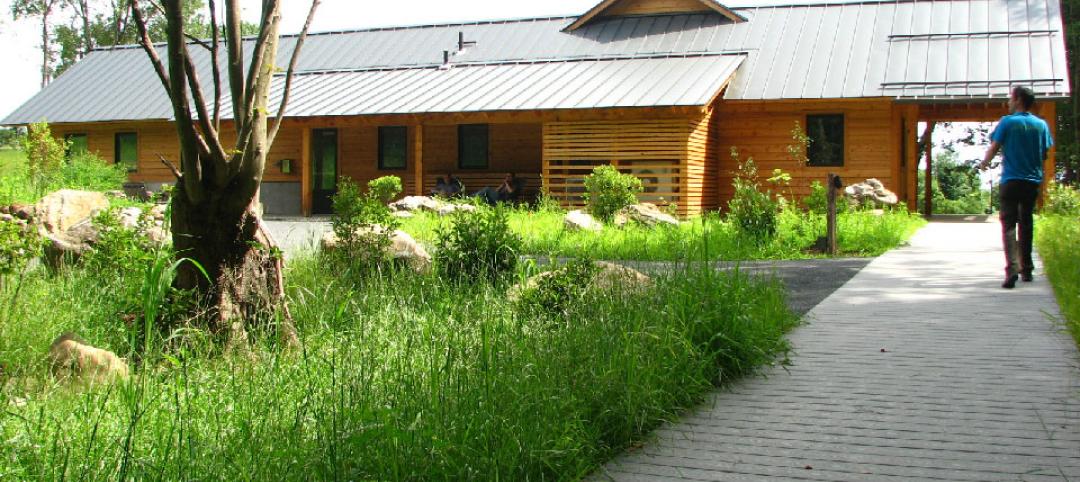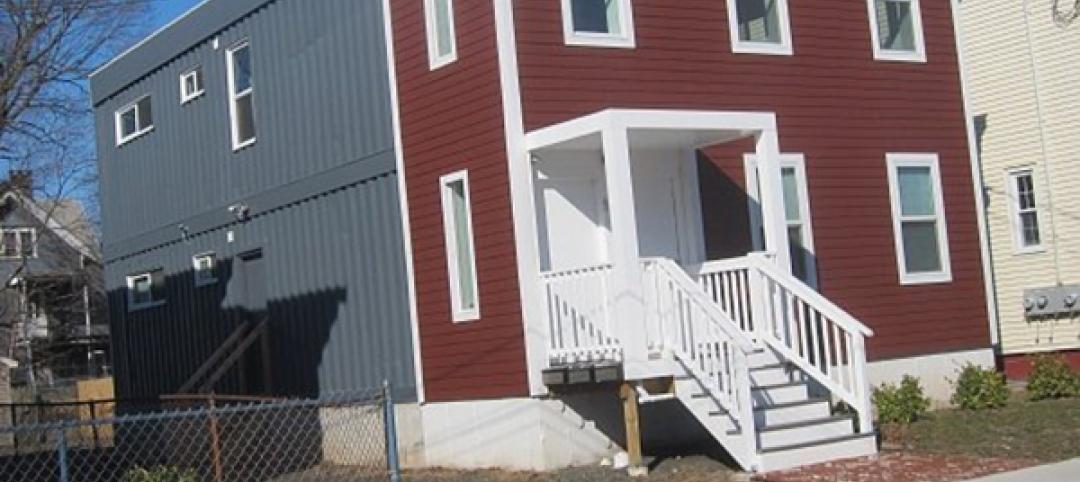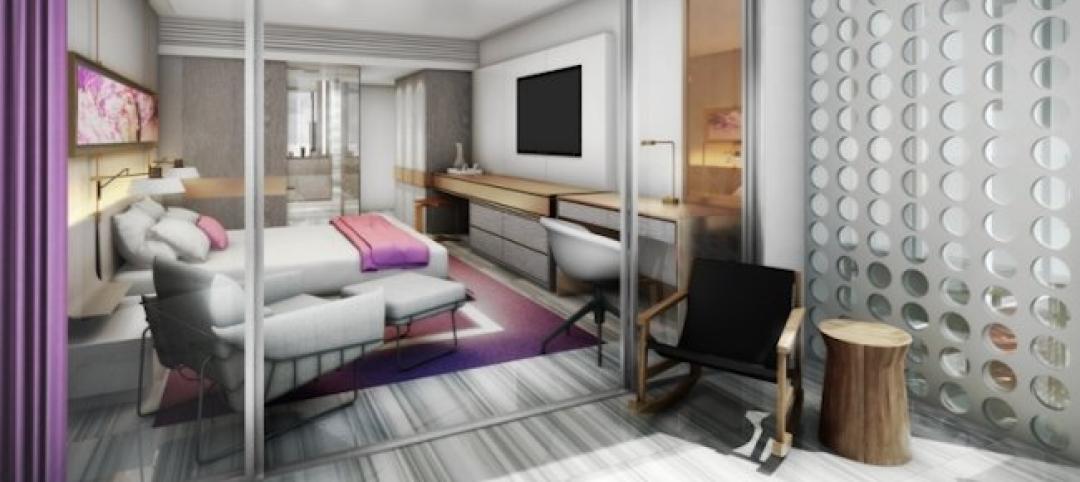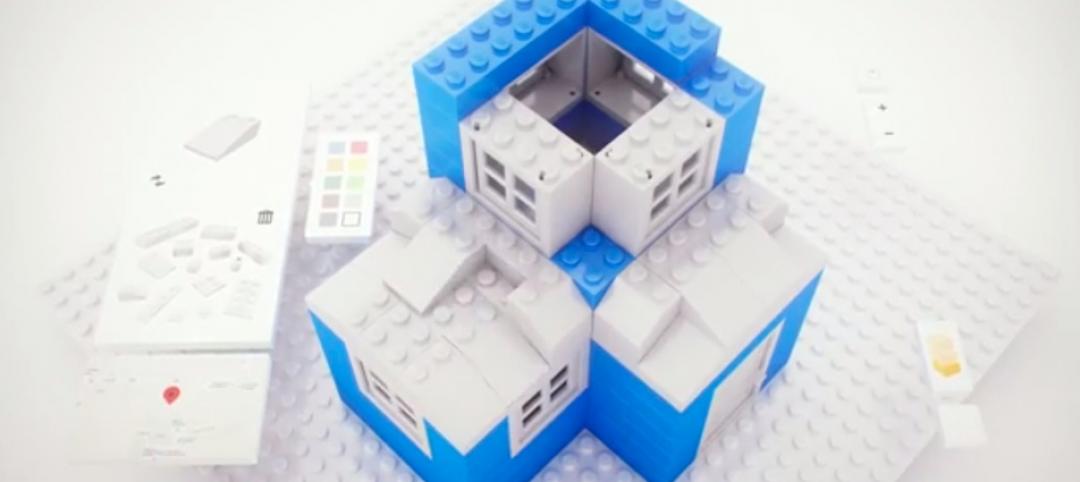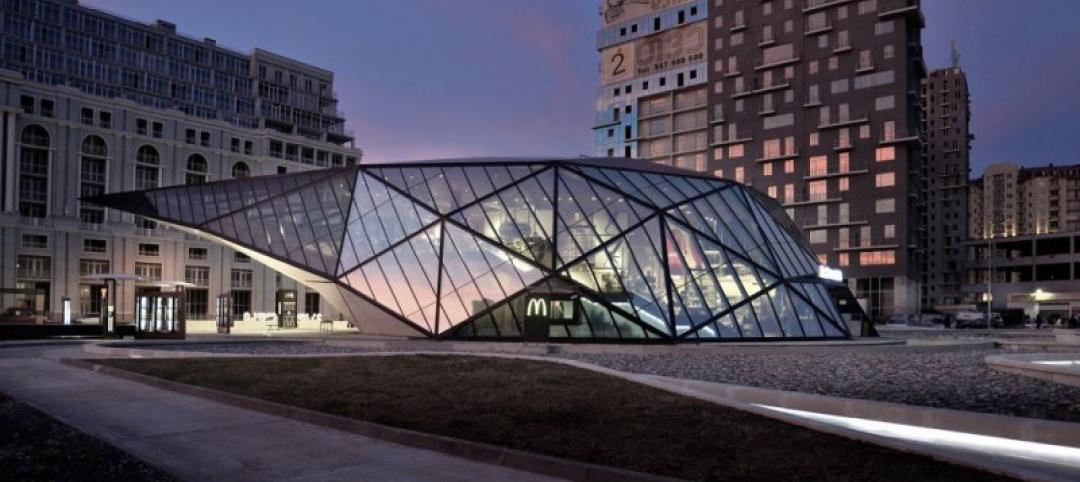In a Building Team Awards competition that was heavy with high-quality healthcare projects, including four eventual winners, the Naval Hospital at Camp Pendleton (NHCP) stood out, according to the awards judges. The jury commended the Building Team for executing an extremely large and complex program under an aggressive schedule and experimental design-build contracting method—all while beating the initial budget by nearly 19%.
“On top of that, this project has a strong environmental story,” said Building Team Awards judge Susan Heinking, AIA, NCARB, LEED AP EB O+M, Sustainability Leader and Vice President with VOA. On track for LEED Gold, the facility outperforms baseline ASHRAE energy standards by 30%, thanks to its daylight-rich interior scheme, 36,000-sf vegetated roof, and 170 kW photovoltaic solar panel array for domestic hot water.
The massive, one-million-sf campus was completed in just 34 months, a full six months ahead of the original schedule and two years faster than any previous NAVFAC hospital project. The Building Team also came in more than $100 million under budget, with less than 2% contractor-requested change orders, zero lost-time incidents, and zero rework needed due to government noncompliance.
The scope of the project entailed building a 500,000-sf hospital with 60 inpatient beds for medical surgery, labor/delivery, post-partum, and intensive care, as well as 96 procedure rooms, 205 exam rooms, and 10 operating rooms; a central utility plant with 3,100 tons of cooling and redundant utility systems; a 1,500-space parking facility; and 1,000 surface parking spaces.
PLATINUM AWARD
Project summary
Naval Hospital at Camp Pendleton
Oceanside, Calif.BUILDING TEAM
Submitting firms: Clark Construction Group, McCarthy Building Cos. (joint venture design-build contractor)
Owner: NAVFAC Southwest
Design architect: HDR Architecture
Architect of record: HKS
Interior architect: Young and Co.
Structural engineer: KPFF Consulting Engineers
Mechanical engineer: TMAD Taylor and Gaines
Electrical engineer: exp.
Civil engineer: BergerABAMGENERAL INFORMATION
Size: 1,000,000 gsf
Construction cost: $447.3 million
Construction: September 2010 to September 2013
Delivery method: Design-build
Funded through the American Recovery and Reinvestment Act of 2009, the project had to be completed in record time (by Navy standards) in order to meet the ARRA requirements. It meant the Building Team would have to compress the project schedule from the typical five- to seven-year time frame to just 40 months—a goal that was ultimately bested by six months.
To expedite the schedule and start construction early, the project team developed a phased-design approach—a first for NAVFAC. The team worked alongside the client to identify critical path activities available for early starts, and eventually divided the project into six design packages.
This approach slashed several weeks off the project schedule. For instance, by sequencing the structural package as one of the first to be reviewed and approved, the hospital’s foundation work kicked off two weeks early. And siphoning a portion of the civil design into an early package facilitated the relocation of two high-voltage transmission lines, which enabled the team to clear the way for an early start of mass grading.
BREAKTHROUGH TURNKEY PROJECT DELIVERY
In a first for the federal government, the design-build team, under a turnkey contracting method, was responsible for not only designing and building the campus, but planning, procuring, and installing all medical equipment, furniture, and artwork, as well as training the hospital staff on the equipment. From the MRI units and blood analyzers to the patient beds and operating room integration, the Building Team was responsible for all aspects of delivery: design, planning, equipment selection, procurement, installation, training, and warranties.
Under the contract, the design-build team—led by Clark Construction Group and McCarthy Building Cos., with HDR Architecture and HKS on the design side—worked hand in hand with NAVFAC to evaluate, select, and coordinate more than 20,000 pieces of equipment for the complex. Every piece of equipment was scrutinized to determine the greatest value to the client, based on life cycle cost, maintenance contracts, model options, and competitive offerings.
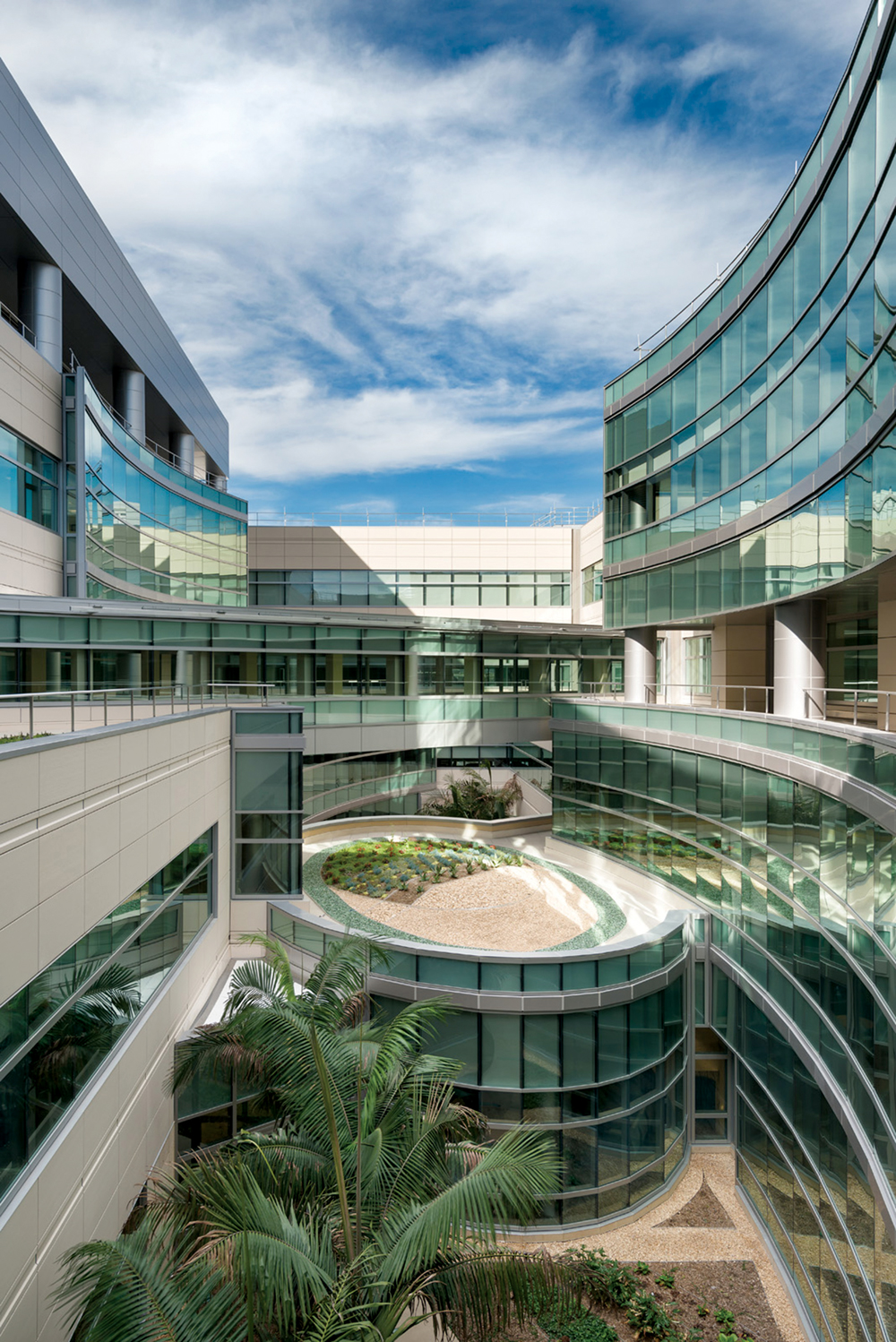
The massive campus was completed in just 34 months, a full six months ahead of the original schedule and two years faster than any previous NAVFAC hospital project. A pocket courtyard adds to the healing environment. Photo: LaCasse Photography
Once the design was finalized, the team worked closely with NAVFAC to understand its funding schedule, and with the equipment manufacturers to develop a procurement schedule. The goal was to delay final equipment selections to ensure the latest technology, without impacting construction or requiring rework. After the client settled on specific equipment, Clark/McCarthy secured a purchase order from the manufacturer, coordinated lead times with the construction schedule, and incorporated just-in-time delivery to the site, which eliminated the need for temporary warehousing.
5D BIM MODEL PAYS OFF
From the project’s inception, the team worked entirely in three dimensions to design and coordinate the hospital, including its civil infrastructure, building superstructure, envelope, building systems, and interior spaces.
During design development, the model helped the team accurately determine the budget and constructability. The model was linked to the project’s cost-loaded CPM schedule to produce a 5D tool (3D geometry, time, cost) that automatically adjusted when changes were made.
Using the model, the team prefabricated numerous materials and components, including mechanical systems, window and exterior framing assemblies, ductwork, piping, casework, pneumatic tube system, and electrical distribution systems.
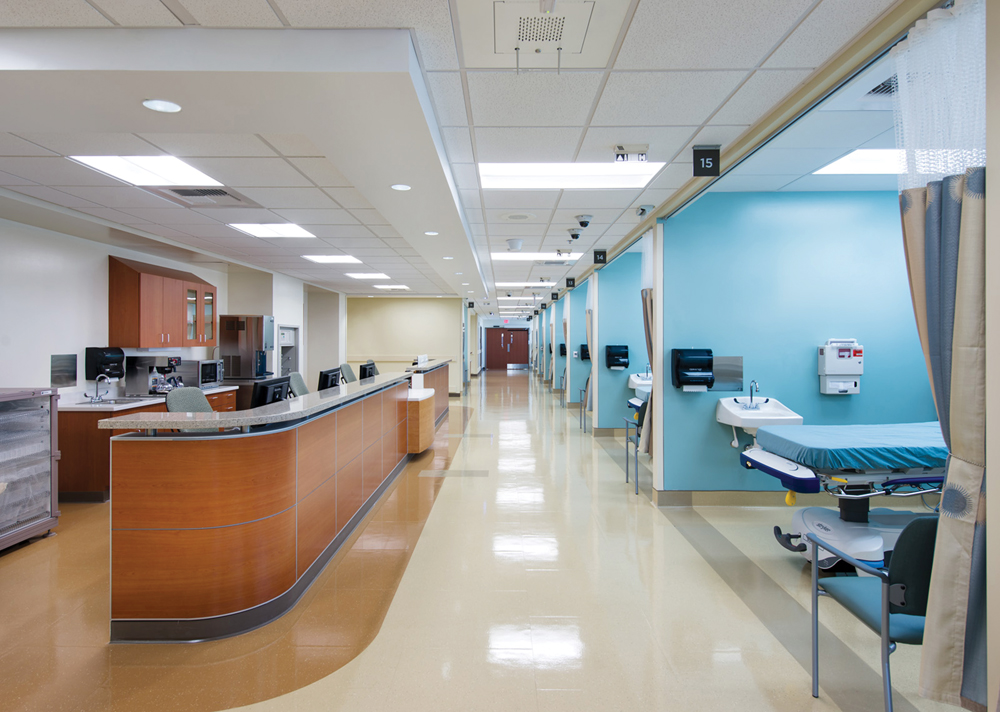
Navy Medicine West personnel were integrated into the project team to provide valuable counsel on how to design and build the most functional spaces for hospital staff. The team used BIM to produce virtual mockups, in conjunction with physical mockups, for a half-dozen major medical spaces. The digital layouts helped coordinate all in-wall and overhead MEP and mechanical spaces, doors, and stud locations, as well as provide tools for early validation by the clinical staff. Photo: LaCasse Photography
From the successful implementation of an experimental turnkey contract method to the use of 5D BIM for advanced collaboration, the Naval Hospital at Camp Pendleton will serve as model for federal healthcare facilities delivery for years to come.
Related Stories
| Feb 5, 2014
BIA Opens Entries for 25th Annual Brick in Architecture Awards
Entries open on February 10 for the Brick Industry Association's (BIA) Brick in Architecture Awards. Celebrating its silver anniversary, BIA's annual honors spotlight outstanding, innovative and sustainable architecture that incorporates clay brick products as the predominant exterior building or paving material.
| Feb 5, 2014
Multifamily Housing, Green Building, Market Trends, Innovation to be Prime Topics at MBI’s World of Modular
More than 600 developers, contractors, architects, builders, dealers and equipment/service suppliers are expected at the event, slated for March 21-24 in San Antonio, Texas, and hosted by the Modular Building Institute.
| Feb 5, 2014
7 towers that define the 'skinny skyscraper' boom [slideshow]
Recent advancements in structural design, combined with the loosening of density and zoning requirements, has opened the door for the so-called "superslim skyscraper."
| Feb 4, 2014
World's fifth 'living building' certified at Smith College [slideshow]
The Bechtel Environmental Classroom utilizes solar power, composting toilets, and an energy recovery system, among other sustainable strategies, to meet the rigorous performance requirements of the Living Building Challenge.
| Feb 4, 2014
Must see: Student housing complex made with recycled shipping containers
Architect Christian Salvati's new structure is just the first step in bringing shipping container construction to New Haven, Conn.
| Feb 3, 2014
Gehry wins bid to design Berlin's tallest tower [slideshow]
The architect's "rotating cubes" scheme for the 300-unit residential tower beat out design submissions by eight other prominent firms, including Adjaye Associates and David Chipperfield Architects.
| Jan 31, 2014
Trump Hotel Collections announces luxury hotel for Rio de Janeiro
The 13-story, 171-guestroom Trump Rio will be Trump Hotel Collection’s first property in South America and the only luxury hotel in the neighborhood when it opens in 2016.
| Jan 31, 2014
LEGO, Google partner to develop 3D modeling tool for LEGO structures
The free tool, called Build, allows Chrome users to create virtual 3D structures using any shape and color in the LEGO catalog.
| Jan 31, 2014
Ultra-modern McDonald's restaurant voted one of world's best new buildings
This McDonald's, which is combined with a fuel station and recreation areas, was awarded the Best Commercial Building of the Year by architecture website ArchDaily.
| Jan 31, 2014
6 considerations for rehabbing student union buildings
Most colleges and universities feel pressure to offer the latest amenities in order to attract and retain the best and brightest students. While hauling in the bulldozer to create modern facilities is attractive in some regards, deciding to renovate can be just as effective and, in some cases, even preferable to new construction.


